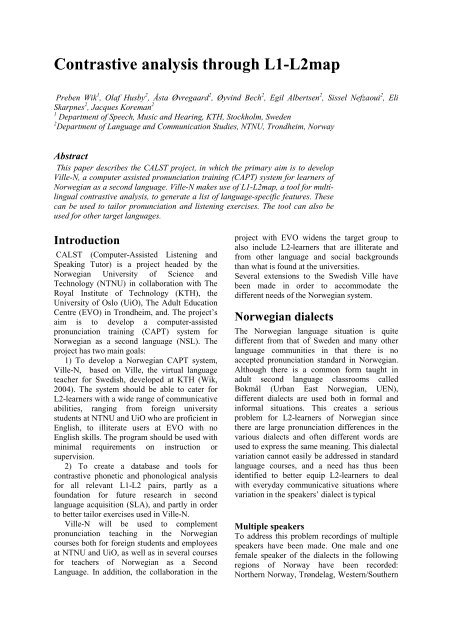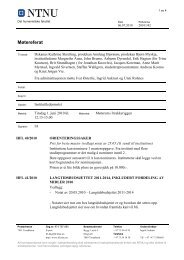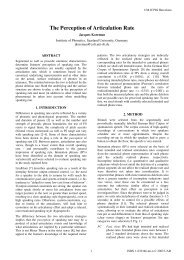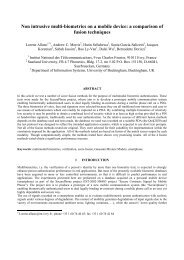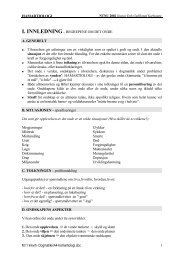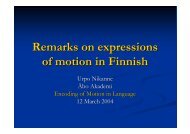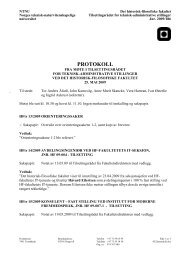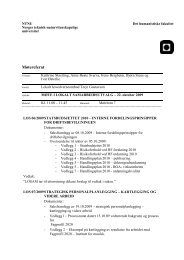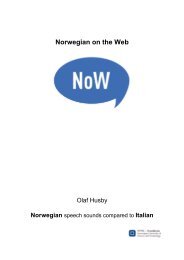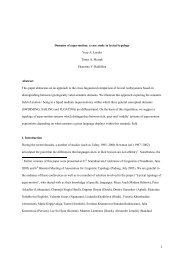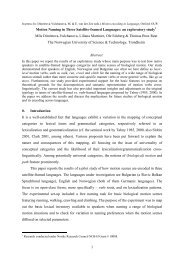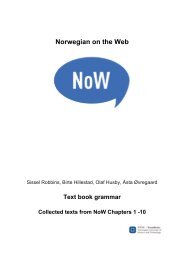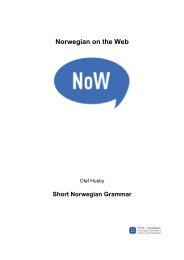Contrastive analysis through L1-L2map - NTNU
Contrastive analysis through L1-L2map - NTNU
Contrastive analysis through L1-L2map - NTNU
Create successful ePaper yourself
Turn your PDF publications into a flip-book with our unique Google optimized e-Paper software.
<strong>Contrastive</strong> <strong>analysis</strong> <strong>through</strong> <strong>L1</strong>-<strong>L2map</strong><br />
Preben Wik 1 , Olaf Husby 2 , Åsta Øvregaard 2 , Øyvind Bech 2 , Egil Albertsen 2 , Sissel Nefzaoui 2 , Eli<br />
Skarpnes 2 , Jacques Koreman 2<br />
1 Department of Speech, Music and Hearing, KTH, Stockholm, Sweden<br />
2 Department of Language and Communication Studies, <strong>NTNU</strong>, Trondheim, Norway<br />
Abstract<br />
This paper describes the CALST project, in which the primary aim is to develop<br />
Ville-N, a computer assisted pronunciation training (CAPT) system for learners of<br />
Norwegian as a second language. Ville-N makes use of <strong>L1</strong>-<strong>L2map</strong>, a tool for multilingual<br />
contrastive <strong>analysis</strong>, to generate a list of language-specific features. These<br />
can be used to tailor pronunciation and listening exercises. The tool can also be<br />
used for other target languages.<br />
Introduction<br />
CALST (Computer-Assisted Listening and<br />
Speaking Tutor) is a project headed by the<br />
Norwegian University of Science and<br />
Technology (<strong>NTNU</strong>) in collaboration with The<br />
Royal Institute of Technology (KTH), the<br />
University of Oslo (UiO), The Adult Education<br />
Centre (EVO) in Trondheim, and. The project’s<br />
aim is to develop a computer-assisted<br />
pronunciation training (CAPT) system for<br />
Norwegian as a second language (NSL). The<br />
project has two main goals:<br />
1) To develop a Norwegian CAPT system,<br />
Ville-N, based on Ville, the virtual language<br />
teacher for Swedish, developed at KTH (Wik,<br />
2004). The system should be able to cater for<br />
L2-learners with a wide range of communicative<br />
abilities, ranging from foreign university<br />
students at <strong>NTNU</strong> and UiO who are proficient in<br />
English, to illiterate users at EVO with no<br />
English skills. The program should be used with<br />
minimal requirements on instruction or<br />
supervision.<br />
2) To create a database and tools for<br />
contrastive phonetic and phonological <strong>analysis</strong><br />
for all relevant <strong>L1</strong>-L2 pairs, partly as a<br />
foundation for future research in second<br />
language acquisition (SLA), and partly in order<br />
to better tailor exercises used in Ville-N.<br />
Ville-N will be used to complement<br />
pronunciation teaching in the Norwegian<br />
courses both for foreign students and employees<br />
at <strong>NTNU</strong> and UiO, as well as in several courses<br />
for teachers of Norwegian as a Second<br />
Language. In addition, the collaboration in the<br />
project with EVO widens the target group to<br />
also include L2-learners that are illiterate and<br />
from other language and social backgrounds<br />
than what is found at the universities.<br />
Several extensions to the Swedish Ville have<br />
been made in order to accommodate the<br />
different needs of the Norwegian system.<br />
Norwegian dialects<br />
The Norwegian language situation is quite<br />
different from that of Sweden and many other<br />
language communities in that there is no<br />
accepted pronunciation standard in Norwegian.<br />
Although there is a common form taught in<br />
adult second language classrooms called<br />
Bokmål (Urban East Norwegian, UEN),<br />
different dialects are used both in formal and<br />
informal situations. This creates a serious<br />
problem for L2-learners of Norwegian since<br />
there are large pronunciation differences in the<br />
various dialects and often different words are<br />
used to express the same meaning. This dialectal<br />
variation cannot easily be addressed in standard<br />
language courses, and a need has thus been<br />
identified to better equip L2-learners to deal<br />
with everyday communicative situations where<br />
variation in the speakers’ dialect is typical<br />
Multiple speakers<br />
To address this problem recordings of multiple<br />
speakers have been made. One male and one<br />
female speaker of the dialects in the following<br />
regions of Norway have been recorded:<br />
Northern Norway, Trøndelag, Western/Southern
Norway and Southeastern Norway (UEN). All in<br />
all 8 different voices will be used in the<br />
program, accompanied by 8 different embodied<br />
conversational agents (ECAs), to give each<br />
voice a personality.<br />
The learner can select an ECA from the GUI<br />
and listen to and practice one specific dialect, or<br />
train across dialects in the same exercise and let<br />
the program select the target voice.<br />
As reported by several researchers, including<br />
McAllister (1998), it is good to listen to many<br />
different speakers in order to achieve better<br />
listening comprehension. Multiple-talker models<br />
have been reported as particularly effective to<br />
improve perception of novel contrasts (c.f.<br />
Logan et al., 1991; Probst et al., 2002), as the<br />
inherent variability allows for induction of<br />
general phonetic categories or other L2 specific<br />
salient features.<br />
Learners will also be able to run the exercises<br />
with one specific dialect in mind, which is<br />
useful when selecting a role model for<br />
pronunciation in production exercises. The<br />
advantage of having both male and female<br />
voices in each dialect becomes apparent in this<br />
case to allow learners to choose a role model<br />
with the same gender as themselves.<br />
Hyper-articulated recordings<br />
The native speakers who made the recordings<br />
were informed to speak as they normally do<br />
with normal speed, reductions and<br />
coarticulations, in order to offer the learners<br />
spoken utterances that are as close to authentic<br />
speech as possible. It is however difficult for<br />
beginners to assimilate reductions and<br />
coarticulations in the early phases of learning,<br />
and it is often common practice to speak slower<br />
and clearer when speaking to L2 learners who<br />
are in an early phase of development. To<br />
incorporate such considerations in the program<br />
two options were considered: To make it<br />
possible for the learners within the program to<br />
slow down the speech samples by manipulating<br />
the acoustic signal, or to make double<br />
recordings, one normal and one slow hyperarticulated<br />
version of all the recordings. The<br />
difference between slow and normal speech is<br />
not uniformly distributed, as for example<br />
plosives are not stretched in the release burst but<br />
only in the occlusion. Long vowels are typically<br />
exaggerated, coarticulations will be reduced or<br />
removed, and other aspects of the speech such as<br />
the lexical stress will be affected differently with<br />
stressed syllables being stronger and more<br />
emphasized in a hyper-articulated version. It<br />
was hence decided that to ensure the best<br />
possible quality in the learning material,<br />
exaggerated, hyper-articulated versions of all<br />
recordings were made even if it would include<br />
more work and a larger set of recordings.<br />
The learners have the option to choose to do<br />
the exercises using either type of recording, or a<br />
learner can choose to use normal recordings and<br />
select a: “Say again” button, to get a repetition<br />
of the last spoken word in a hyper-articulated<br />
version.<br />
Wordlists<br />
A wordlist of basic vocabulary from the course<br />
books used by the participating institutions has<br />
been created and categorized into semantic<br />
categories. Approximately 1000 words were<br />
selected from the aggregated wordlists and<br />
divided into 43 categories. The criterion for the<br />
selection of the base vocabulary was also that it<br />
should satisfy the A1 and A2 vocabulary range<br />
of CEFR, (Common European Framework of<br />
Reference for Languages)<br />
All words have then been visualized.<br />
Approximately 30% of the images are from<br />
“UVic's Language Teaching Clipart Library”.<br />
For words where no appropriate image was<br />
found complementary drawings have been made<br />
by a local artist in the same artistic style as the<br />
drawings from the internet, in order to get a<br />
consistent and coherent set of images.<br />
English translations, transcription and the<br />
inflection of words have been added, and as<br />
mentioned above, sound files have been<br />
recorded for the aggregated wordlist, in four<br />
dialects, with one male and one female speaker<br />
for each dialect, and in both normal and hyperarticulated<br />
versions.<br />
The <strong>L1</strong>-<strong>L2map</strong><br />
The contrastive <strong>analysis</strong> hypothesis (CAH) as<br />
presented in Lado (1957), claims all problems in<br />
learning a foreign language can be explained<br />
from transfer problems induced by the learner’s<br />
native language. It is today generally accepted<br />
that the claims made by the CAH are too strong,<br />
and that there are other factors which determine<br />
the difficulty language learners have with<br />
acquiring new sounds (Eckman, 1977; Odlin,<br />
1989; Flege, 1995; Major, 2001). This does<br />
however not mean that CAH should be
completely rejected or abandoned. As stated by<br />
Ellis (1994)<br />
“The problem with CAH is that it is too simplistic and<br />
too restrictive. The solution as many researchers have come<br />
to recognize, lies not in its abandonment but in careful<br />
extension and revision”<br />
The second task in the CALST project is to<br />
design and evaluate a revised and extended<br />
contrastive <strong>analysis</strong> tool called <strong>L1</strong>-<strong>L2map</strong>. Since<br />
the problematic aspects of the L2 are not the<br />
same for all learners, the aim of the CAPT<br />
system is to assist learners (and teachers) in<br />
identifying the problematic aspects for each<br />
individual, and work on these contrasts with<br />
special exercises. The idea with <strong>L1</strong>-<strong>L2map</strong> is to<br />
make the CAPT system informed by <strong>L1</strong> specific<br />
filtering.<br />
The <strong>L1</strong>-<strong>L2map</strong> will serve as a platform for<br />
researchers with a phonetic background to<br />
encode language data and make it available in a<br />
format that can be used by CAPT creators. <strong>L1</strong>-<br />
<strong>L2map</strong> is designed as a wiki with two levels of<br />
users.<br />
First of all as a generally accessible tool,<br />
where any user can access the data and browse<br />
and compare the phonological features of<br />
different languages. A group of specialists will<br />
have administrative rights and the responsibility<br />
for inserting feature data about languages that<br />
they have phonetic-linguistic competence for.<br />
Each language is thus encoded individually by<br />
an expert in that particular language, and the<br />
contrastive <strong>analysis</strong> is performed by<br />
'superimposing' the data for two languages on<br />
top of each other.<br />
The <strong>L1</strong>-<strong>L2map</strong> can carry out an automatic<br />
contrastive <strong>analysis</strong> where the source language<br />
can be chosen from a large number of<br />
languages, with (one of the dialects of)<br />
Norwegian as the target language. The first<br />
version of the <strong>L1</strong>-<strong>L2map</strong> is based on the UPSID<br />
database, which contains 451 languages<br />
(Maddieson, 1980). This number has been<br />
increased to more than 500 languages in <strong>L1</strong>-<br />
<strong>L2map</strong>. As shown in Figure 1, the result of the<br />
contrastive <strong>analysis</strong> is displayed in four tabs.<br />
The choice of tabs is based on the IPA<br />
representation: “Consonants”, “Consonants<br />
(other)”, “Vowels” and “Diphthongs”. The<br />
“Consonants” tab presents pulmonic consonants,<br />
while non-pulmonic consonants and affricates<br />
are presented in “Consonants (other)”. The latter<br />
is only shown if relevant for the <strong>L1</strong>-L2<br />
comparison. For the sake of simplicity rows in<br />
the consonant tables (representing manner of<br />
articulation) are only visualized if used in at<br />
least one of the languages. A fifth, “Language<br />
information” tab presents some general<br />
information, following the information given in<br />
UPSID. A lay-out which is very similar to that<br />
used in IPA was used in order to provide<br />
language experts using the system with a simple<br />
and recognizable lay-out.<br />
As shown in Figure 1, a color scheme is<br />
employed in the visualization of the data. The<br />
first language chosen is blue and assumed <strong>L1</strong><br />
status, the second language chosen is red and<br />
assumed L2 status, and the features they have in<br />
common (where there is an overlap) are green.<br />
This way it becomes apparent for the L2 learner<br />
which features are different from their <strong>L1</strong> (red),<br />
and thus needs attention since they are absent in<br />
the <strong>L1</strong>.<br />
Extensions to UPSID<br />
The UPSID database only lists sounds that are<br />
distinct phonemes in any given language. It is<br />
not enough to do a simple comparison of which<br />
sounds constitute phonemes in each language. A<br />
number of extensions are in the process of being<br />
added to the <strong>L1</strong>L2-Map. These include<br />
positional restrictions, syllable structure<br />
(phonotactics), tone, stress, and timing.<br />
Positional phonemic restrictions<br />
The positions in which sounds occur in syllables<br />
must be taken into account. Difficulties that<br />
could be predicted from CAH if position is part<br />
of the description, will otherwise go by<br />
unnoticed. For example in Mandarin, only two<br />
consonants ([ŋ] and [n]) are allowed at the end<br />
of a syllable, even if many other consonants<br />
appear in syllable initial position. A<br />
consequence of this is that many consonants<br />
which can occur at the end of Norwegian<br />
syllables present a difficulty for learners of<br />
Norwegian with Mandarin as <strong>L1</strong>.<br />
The <strong>L1</strong>L2-map presented in Figure 1 is the<br />
complete set of consonants in both Norwegian<br />
and Mandarin, taken from the UPSID data,<br />
where positional restrictions are not taken into<br />
account. In the next version of <strong>L1</strong>-<strong>L2map</strong>, this<br />
pane will be divided into three separate panes,<br />
with each pane only displaying the phonemes<br />
that are allowed in initial medial, and final<br />
position respectively.
Figure 1 Visualization of the consonant part of the <strong>L1</strong>-<strong>L2map</strong>. Here exemplified with Mandarin as<br />
<strong>L1</strong> in blue, Norwegian as L2 in red. Overlapping phonemes displayed in green.<br />
Syllable structure (phonotactics)<br />
Not only positional restrictions, but also the<br />
phonotactic constraints of languages<br />
(restrictions on the permissible combinations of<br />
phonemes) will be encoded in the <strong>L1</strong>L2-map.<br />
Norwegian has a relatively complex syllable<br />
structure comparable to that of Swedish, and<br />
constitute a difficult part of acquiring the<br />
language for many learners.<br />
Permissible consonants and consonant<br />
clusters in onset and coda will be encoded into<br />
separate lists in the database, and when a<br />
contrastive <strong>analysis</strong> is performed between the<br />
learners <strong>L1</strong> and the L2 clusters that are<br />
allowable combinations in the L2 but missing<br />
from the learners <strong>L1</strong> will be extracted.<br />
<strong>L1</strong>-<strong>L2map</strong> is a useful tool for developers of<br />
CAPT systems for any language, as well as for<br />
language teachers. The tool allows the insertion<br />
of new languages and/or dialects, and outputs<br />
useful information about the L2 phones which<br />
L2 learners need to acquire.<br />
The <strong>L1</strong>-<strong>L2map</strong> is available online:<br />
http://calst.hf.ntnu.no/l1-l2map<br />
Acknowledgements<br />
We are grateful for financial support from<br />
Norgesuniversitetet, project number P54/2009,<br />
and to Henning Reetz for making the scripts for<br />
his UPSID interface (web.phonetik.unifrankfurt.de/upsid.html)<br />
available.<br />
References<br />
Eckman, F. R. (1977). Markedness and the<br />
contrastive <strong>analysis</strong> hypothesis. Language<br />
Learning, 27(2), 315-330.<br />
Ellis, R. (1994). The Study of Second Language<br />
Acquisition. Oxford University Press.<br />
Flege, J. E. (1995). Second language speech learning:<br />
Theory, findings, and problems. Speech perception<br />
and linguistic experience: Issues in cross-language<br />
research, 233-277.<br />
Lado, R. (1957). Linguistics across cultures.<br />
University of Michigan Press.<br />
Logan, J. S., Lively, S. E., & Pisoni, D. B. (1991).<br />
Training Japanese listeners to identify<br />
English/r/and/l: A first report. Journal of the<br />
Acoustical society of America, 89(2), 874-886.<br />
Maddieson, I. (1980). UPSID: UCLA phonological<br />
segment inventory database. Phonetics Laboratory,<br />
Department of Linguistics.<br />
Major, R. C. (2001). Foreign accent: The ontogeny<br />
and phylogeny of second language phonology.<br />
Lawrence Erlbaum.<br />
McAllister, R. (1998). Second language perception<br />
and the concept of foreign accent. In STiLL-Speech<br />
Technology in Language Learning.<br />
Odlin, T. (1989). Language Transfer. Cambridge<br />
University Press.<br />
Probst, K., Ke, Y., & Eskenazi, M. (2002).<br />
Enhancing foreign language tutors-In search of the<br />
golden speaker. Speech Communication, 37(3-4),<br />
161-173.<br />
Wik, P. (2004). Designing a virtual language tutor. In<br />
Proc of The XVIIth Swedish Phonetics Conference,<br />
Fonetik 2004 (pp. 136-139). Stockholm University.


